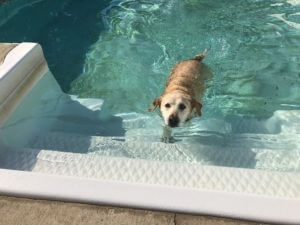How to Keep Your Dog Safe in Bodies of Water
No matter where you live, you have access to a body of water. It may be the ocean, the river, or even the backyard pool. Chances are that you want to share opportunities to swim and cool off with your four-legged friend.

Letting your dog enter bodies of water and swim can be a great experience for both you and them. But before you head out with your furry pooch, there are a few things you should know about keeping your dog safe in bodies of water. Not all water is safe for pups, and for various reasons. On top of that, you want to be sure your dog is ready, willing, and able to take on any challenges that might come with swimming.
With this in mind, here are some questions to ask yourself before letting your pooch go for a splash in order to be safe.
Can Your Dog Swim?
Make sure to actually consider this question, and don’t take for granted that the answer is “yes.”
While most dogs are natural-born swimmers, some breeds aren’t meant to float as much as they are to sink. Deep, broad-chested are not built for swimming because their density and limb size can make swimming difficult. Dogs with what is typically referred to as “smashed” or “smooshed” faces, like pugs and Pekingese, may have trouble breathing without inhaling water.
On top of body type concerns, you also have to keep in mind your dog’s capabilities, athleticism, and comfort level.
If you have never seen your dog swim, assuming that they can’t is the best course of action. Introduce your dog to the water slowly and on a leash. Wrap your arm around your dog’s chest or, if your dog is very large, help hold his hind end up. The hope is that your dog starts to paddle his feet by instinct and, while it may look clumsy at first, the floundering should quickly turn into full-fledged swimming.
The one thing you never want to do is to throw your dog in the water and see what happens. If your dog is not a natural swimmer or is not fond of the water, this could throw him into a panic and instill a fear of water you won’t be able to break.
No matter how good of a swimmer your dog is, only let them swim for a few minutes at a time with plenty of breaks in between. Keep them hydrated with a clean water source (ie probably not the water they’re swimming in), and watch for signs of exhaustion.
Also, give your dog the same safety protocols you would a human. Don’t let them swim unsupervised, and provide a life vest for any body of water too deep for them to stand in.
Is the Water Safe?
Before deciding where you will take your dog to enjoy the water, make sure that water is safe.
Some rivers have currents that flow too quickly. Ocean waves can sweep over a dog and cause them to aspirate or become disoriented. Some lakes have dangerous algae blooms that can be toxic to people and pets.
If you’re taking your dog into a swimming pool, be sure that harsh chemicals haven’t just been added to the water. Keep an eye on your dog around the edge of the pool just as you would a child.
Also, be sure to check the temperature of the water. Your dog may be able to handle cooler temperatures than you, but cold water can have the same effects on dogs as it does on humans. Any water colder than 70 °F can sap heat away quickly and lead to exhaustion or hypothermia. Water 90 °F – 115 °F can harbor dangerous amoebas and other harmful bacteria.
Always take a moment to consider these factors, and decide on the safest course given the known vs. unknown risks.
Can Your Dog Drink the Water?
Water that’s safe for your dog to swim in is not always safe for them to drink. Drinking from a river is not the same as drinking fresh water from municipal sources. Discourage your dog from drinking from any natural body of water that might contain contaminants, especially if it’s still water rather than flowing water. Water that’s been treated with chemicals, such as pool water, is never safe to drink.
Your pup may take a few laps with their tongue while they take laps around the lake, and that does not necessarily cause for worry. But don’t think this water is ok to replace water from a known safe drinking source. Make sure that your dog has the ability to drink plenty of fresh water throughout the day. Swimming is exercise, and your dog needs to stay hydrated.
Did You Remember to Rinse?
Any time your dog gets out of a body of water, he needs to be rinsed off with fresh water. This will remove any algae, debris, and other contaminants that could have been introduced to his fur.
After your dog is rinsed off, make sure that his ears are dry. This is especially important with dogs who have floppy ears! Otherwise, the moisture could harbor bacteria, fungus, or other nasty microorganisms that could lead to infection or worse.
Remember You and Your Dog Have Limitations
It’s easy to forget that your dog has limitations just like you do. They always seem to be much more athletic than us, and they rarely let us know they’re low on energy until it’s nap time.
Keep in mind that your dog can only do so much and will often push themselves further than they should. It’s up to you to make sure that your dog is taking frequent breaks and that you are ending the outing before your dog is overly tired.
Give Your Pup Swimming Lessons at a Fun Doggie Daycare Near You
Having your pet accompany you on outings is always fun, especially when those outings are on the water. Follow the tips above so you and your pet both enjoy the day to the fullest!
If you want to get a feel for your dog’s abilities or make sure it’s got swimming down pat, you can always take him or her to a Greenlin Pet Resort facility near you. Our dog daycare services include access to swimming pools designed especially for dogs. We can offer swimming lessons, supervised play, and training tips based on our expert observations. Plus, it’s a great way to keep your dog entertained compared to being stuck in the house!
Call us or contact us online to learn more about our services, then and come visit a Greenlin Pet Resorts location near you.
